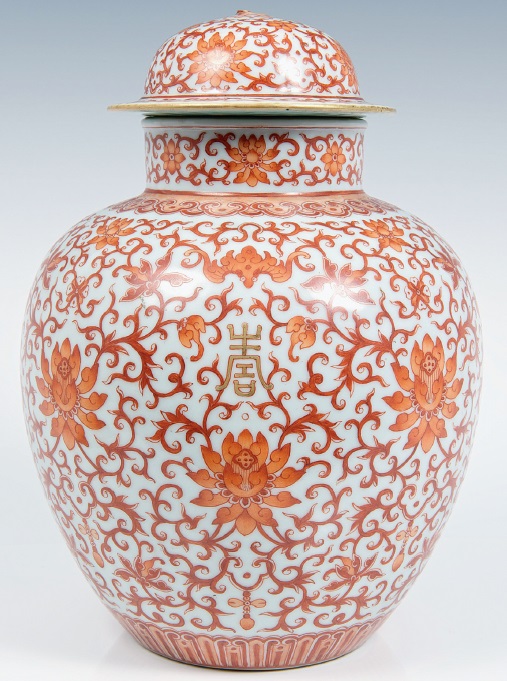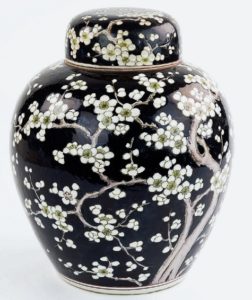Ginger Spice – collecting Chinese ginger jars

Universally recognised by their high shoulders and domed lids Chinese ginger jars come in a remarkable range of colours, patterns, and dimensions. As a result, antique ginger jars are a perennial favorite among porcelain collectors.
A classical ginger jar is characterised by its rounded, very much ovoid shape and the high shoulders. The name ginger jar is a western invention whereas in China, these jars were used to store herbs. In Chinese the shape is simply called ‘guan’, or jar. Very often the original covers are lost and have been replaced by matching porcelain lids or finely carved wooden covers with intricate openwork decoration.
The ginger jar first originated in the days of the Qin dynasty (221-207BC) as a means for storing spices ranging from salt to more specialized herbs, including ginger. These jars became an essential means of both storing and transporting spices, and thus when ginger became a chief export to the Western world, the vessels became known as ‘ginger’ jars.
Though these pieces were originally intended as utilitarian objects, they often embodied the rich colours and vibrant patterns characteristic of Chinese ceramics. As time progressed, their beauty was increasingly celebrated, so much so that by the 19th century ginger jars were more renowned for their design than for their deemed storage purpose.
Dr. Arne Sildatke, Auctionata’s head of the Asian Art, said: “Ginger jars became objects of interior design, especially in the 18th and 19th centuries when they were highly fashionable in Europe as luxurious export goods.”

Since that point in history, the ginger jar has become a coveted collector’s item. Ranging from the traditional blue and white patterns to the more elaborate multicoloured motifs, today antique Chinese ginger jars can be found in museum collections, as well as in modern living rooms.
Oakridge Auction Gallery’s auction coordinator Anna Swetland said: “Aesthetically speaking, ginger jars are great accent pieces and are very versatile in the ways they can be displayed. They are loved by interior decorators that are inspired by Asian art forms and motifs.”
YELLOW, ORANGE AND RED
Some of the rarest examples of antique Chinese ginger jars are adorned in vibrant colours of yellow, orange, and red. Since yellow was originally a colour that was associated with the Emperor of China, it was typically reserved for only the most luxurious creations. The rarity of such pieces in exceptional condition (and accompanied by their original lid) has resulted in a bustling market among collectors. Some of these pieces even incorporate Chinese symbols, which suggests that such pieces might have served as gifts for private ceremonies, such as weddings.
Dr Sildatke said: “Ginger jars have been produced in a wide range of different qualities, from mass-produced items up to premium artworks for a courtly environ ment. The older and the higher the quality of the decoration, the more sought-after. Pieces from the Kangxi period (1662-1722) or the early Qing dynasty in general are regarded as very precious.”
MULTICOLOURED JARS
Equally appealing to collectors are Imari ware ginger jars. Imari ware, which actually originated in Japan, gets its name from the port of Imari in Japan, which was originally its main port of export to the western world. Chinese Imari ware was most prevalent in the 17th and 18th centuries (although it also experienced a resurgence in the later 19th century as well). Characterised by its traditional glazes of blue, red, and gold, Imari ware pieces are often associated with the Kangzi period (1654-1722) of porcelain production, but collectors must be savvy: in some instances ‘Kangzi period’ refers simply to the style, and not necessarily the date, of the piece.
FAMILLE VERTE

On par with Imari ware in terms of quality are those that appear in the famille verte (‘green family’) and famille rose (‘pink family’) styles. Famille verte designs date back to the Ming dynasty, but became formalised in the 1500s into the fivecolour enamel process dominated by rich, yet translucent, shades of green. The famille rose style followed suit in the 18th century and was so named for its characteristic opaque pink shade. that is featured prominently. When comparing the two styles, it is safe to say that the colour range of famille rose wares tend to be more varied and vibrant, yet the older famille verte pieces often have a unique iridescence – thanks to the nature of their glazes – that is beyond compare.
BLUE AND WHITE GINGER JARS
Blue and white are the most traditional and plentiful style of antique ginger jars. This style is also one of the most historic, as examples date to as early as the 9th century. By the days of the Ming dynasty (early 15th century), blue and white style porcelain had developed into its own industry, with European audiences clamouring to copy the style as soon as they could master it. This meant that the export market for blue and white wares from China was a lucrative one, and thus the style became a standard for ginger jars as well.

Anna Swetland said: “As with all Chinese porcelain, Imperial pieces are the most desired by general collectors and Asian art experts alike. Blue and white ginger jars are quite popular.” Similar to the other categories of ginger jars, the blue and white varieties can be difficult to date, in part because often historical eras are applied to pieces as a means of reflecting style, rather than the date.
Dr Sildatke said: “Many of the blue and white ginger jars with Kangxi reign marks were commonly produced in the 19th century – not necessarily as fakes, but in order to honour the era of the great Kangxi Emperor. To determine authenticity, you’ll need experience in order to tell if an item is genuinely from the early Qing dynasty. Take a good look at the composition of the ceramic material and the stylistic details.”
One of the easiest ways to assess the age of a piece is its weight: early ginger jars (those dating to before the 19th century) are often extremely heavy. Though the rationale as to why these earlier pieces carried more weight has been debated – some have suggested, for example, that the added heft was to help balance a ship’s ballast during transport – it can be a good indicator of age, which often impacts the value.
According to the online auction platform thesaleroom.com, in the last six months ginger jars have sold for between £2 and £1,600, with the average hammer price being £87.
This article first appeared on Invaluable.com.

In my tribe , these ginger jars with dome lids are traditionally used as storage for rice wine. These jars were brought to the mountains where our forefathers live when they bartered salt and forest products to the lowland people in the coast who are trading with the Chinese.
I am interested in researching more about the ages of the pieces my mom keeps so I tried reading guidelines as this post. Thanks for posting a very informative guideline. If I may request a minute of your time, may you please have a quick look at these pieces? I posted them here https://hubpages.com/games-hobbies/antique-chinese-porcelain-items
Thank you once again.
I have a, I think a Chinese china Prunus Blossom Blue Ginger Jar Kangxi still complete with crystal ginger filling and dome cap that I believe to be quite old. It has been in the family for as long, long time. Anyone interested?